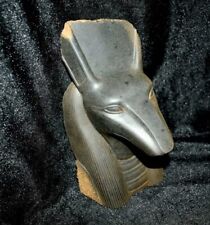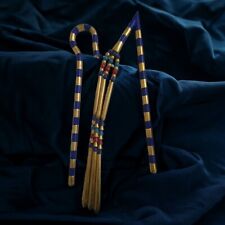 On eBay Now...
On eBay Now...Rare Antique Statue From The Roman Egypt Era Egyptology For Sale

When you click on links to various merchants on this site and make a purchase, this can result in this site earning a commission. Affiliate programs and affiliations include, but are not limited to, the eBay Partner Network.
Rare Antique Statue From The Roman Egypt Era Egyptology:
$128.25
Rare Antique Statue From The Roman Egypt Era Egyptology.. The size as shown in the pics.
Roman Egypt was an imperial province of the Roman Empire from 30 BC to AD 641. The province encompassed most of modern-day Egypt except for the Sinai. It was bordered by the provinces of Crete and Cyrenaica to the west and Judaea, later Arabia Petraea, to the East.
Egypt was conquered by Roman forces in 30 BC and became a province of the new Roman Empire upon its formation in 27 BC. Egypt came to serve as a major producer of grain for the empire and had a highly developed urban economy. It was by far the wealthiest Roman province outside of Italy. The population of Roman Egypt is unknown, although estimates vary from 4 to 8 million. Alexandria, its capital, was the largest port and second largest city of the Roman Empire.
Three Roman legions garrisoned Egypt in the early Roman imperial period, with the garrison later reduced to two, alongside auxilia formations of the Roman army. The major town of each nome (administrative region) was known as a metropolis and granted additional privileges. The inhabitants of Roman Egypt were divided by social class along ethnic and cultural lines.[6] Most inhabitants were peasant farmers, who lived in rural villages and spoke the Egyptian language (which evolved from the Demotic Egyptian of the Late and Ptolemaic periods to Coptic under Roman rule). In each metropolis, the citizens spoke Koine Greek and followed a Hellenistic culture. However there was considerable social mobility, increasing urbanization, and both the rural and urban population were involved in trade and had high literacy rates. In AD 212, the Constitutio Antoniniana gave Roman citizenship to all free Egyptians.
The Antonine Plague struck in the late 2nd century, but Roman Egypt recovered by the 3rd century. Having escaped much of the Crisis of the Third Century, Roman Egypt fell under the control of the breakaway Palmyrene Empire after an invasion of Egypt by Zenobia in 269. The emperor Aurelian (r. 270–275) successfully besieged Alexandria and recovered Egypt. The usurpers Domitius Domitianus and Achilleus took control of the province in opposition to emperor Diocletian (r. 284–305), who recovered it in 297–298. Diocletian then introduced administrative and economic reforms. These coincided with the Christianization of the Roman Empire, especially the growth of Christianity in Egypt. After Constantine the Great gained control of Egypt in AD 324, the emperors promoted Christianity. The Coptic language, derived from earlier forms of Egyptian, emerged among the Christians of Roman Egypt.
Under Diocletian the frontier was moved downriver to the First Cataract of the Nile at Syene (Aswan), withdrawing from the Dodekaschoinos region. This southern frontier was largely peaceful for many centuries, likely garrisoned by limitanei of the late Roman army. Regular units also served in Egypt, including Scythians known to have been stationed in the Thebaid by Justinian the Great (r. 527–565). Constantine introduced the gold solidus coin, which stabilized the economy. The trend towards private ownership of land became more pronounced in the 5th century and peaked in the 6th century, with large estates built up from many individual plots. Some large estates were owned by Christian churches, and smaller land-holders included those who were themselves both tenant farmers on larger estates and landlords of tenant-farmers working their own land. The First Plague Pandemic arrived in the Mediterranean Basin with the emergence of the Justinianic Plague at Pelusium in Roman Egypt in 541.
Authenticity:-
*A rare piece worth owning as shown in the pics
Shipping:We shipping our items using DHL the shipping time depend on payment date and customs in my country and your country.
if you have any question please ask at any time and we will response as soon as possible.if you face any problem before or after receiving the item please call us before take any action.we collect our items carefully and depend on our customers opinion to improve our choice.
Return Policy :we check each product and sell only the best quality products.
In any case, if you are not satisfied with the product, first, please contact us and we will do everything to your satisfaction. In any case, you have a 100% guarantee and refund.
Returns are accepted within 30 days, in its original packaging and on condition the item is in its original condition as received.
Please note that buyer pays for shipping and all additional costs such as tax.
our customers are very important to us . In case of any problem or question, feel free to to contact us and we will do everything we can to make you satisfied.
you are welcome at any time Related Items:
RARE ANCIENT EGYPTIAN ANTIQUES Statue Goddess Isis Breastfeeding Baby God Horus
$269.10
Egyptian God Anubis - Ancient Antique Statue of rare Granite at Pharaonic Era BC
$1450.00
RARE ANCIENT EGYPTIAN ANTIQUE Crook and Flail Symbol Strength & Sovereignty BC
$399.00








